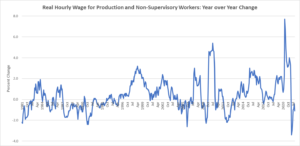November 11, 2021
Those of us who have spent decades trying to call attention to the situation of ordinary workers, and their stagnant wages over the last four decades, are glad to see the media’s newfound interest in real wages (the difference between wage growth and price growth). They have been anxious to highlight the fact that inflation has exceeded the rate of wage growth over the last year.
While that is unfortunate, it is also the case that this is not unusual. Here’s the picture over the last four decades.

Source: Bureau of Labor Statistics.
As can be seen, there are many periods in which wage growth has not kept up with inflation. Starting in the 1980s, wages lagged inflation through most of the decade. This is the period that was known in the media as the “Reagan Boom,” or “morning in America.” Wages did exceed inflation from the mid-1990s to the early 2000s. They then fell behind inflation just before President Bush’s reelection campaign, although the media generally didn’t prominently highlight falling real wages in that election.
Wages again fell behind inflation in the weak recovery from the Great Recession. As the unemployment rate fell, workers again began to see real wage gains in the middle and last part of the decade. There was a surge in real wage growth at the start of the pandemic. This was a composition effect. Many of the lower-paid workers lost their jobs, which raised the average wage for people who were still working.
This year we are seeing this composition effect in reverse. The lower-paid workers are getting rehired, bringing down average pay. This is why the year-over-year change in the real wage was -3.4 percent in April. This was not a story of workers taking massive pay cuts, it was a story of lower-paid workers getting rehired and bringing down the average.
We are still seeing this story. The wage in October of 2020 was boosted by the fact that many lower-paid workers had not yet gotten back their jobs. Now, most of those lower-paid workers are back on the job.
If we look at wage growth over the last two years, it comes out to 2.1 percent, or an average of 1.05 percent annually. That’s not great, but that’s much better than workers did through most of the last four decades, especially the years when Republicans were in the White House.
Just to be clear, we absolutely should be concerned about inflation and real wage growth. Workers should be sharing in the benefits of the economy’s growth, and if wages are not keeping pace with inflation, then most likely they are not. (Benefits like the child tax credit do change the picture somewhat.)
But, we should try to look at these numbers carefully. One year-over-year comparison does not tell us much. If we are still looking at 6.0 percent year-over-year inflation in the spring, and there has been no uptick in wage growth, then we should be asking seriously about how workers are faring. But given the media’s decades of ignoring the plight of ordinary workers, it is hard to take the newfound concern very seriously.







Comments